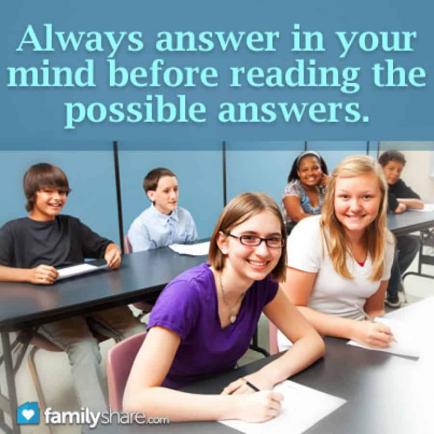
Your child will have several tests in their academic career. Helping them go into testing prepared will give them the confidence they need and reduce the dreaded test anxiety. When taking tests, nothing beats preparation. Putting spelling words, vocabulary, or other facts onto note cards or sticky notes and sticking them around the house is a convenient way to prepare for tests and get the material to sink into your child's brain. Not only do they practice the material when preparing the notes, they also see it as they go about their day. (The whole family can become experts on the French Revolution, or whatever else the student is studying.)
There are several strategies that can help your child when they are taking a test or find themselves "stuck"� on an answer. When sitting down to a test, your child should employ a few methods to best use their time.
-
Always read all the directions - sometimes a teacher will put something in the directions that is critical for the test. (There are several variations of this exercise, but there are teachers that give out a test that says something like: "Put your name at the top of the page and turn to page 6. Write your favorite animal on the line at the bottom of the page and turn in this test."� If the student is paying attention, she will skip all of the other work and get a perfect score.)
-
Do not spend too much time on one question; if you are stuck, mark it, skip it and go back at the end.
-
Focus on the areas that have the heaviest weight for the final grade.
-
Always study, get enough sleep and eat a healthy meal for the day of a test.
In addition to these generalized tips and tricks, the different types of questions typically asked on a test have different tricks if you are stuck. Multiple choice are one of the more common types of tests, and if the test was prepared by the teacher, rather than randomly generated by a computer, there are several human tendencies that come out while writing the tests.
Multiple choice tricks & tips
Always answer in your mind before reading the possible answers. When you find a choice that matches your initial answer, mark it and move on. If you have skipped a question and are coming back to it and are going to guess, there are some smart ways to guess on multiple choice tests.
-
Teachers rarely put the same letter answer twice in a row. (2 B's, etc.)
-
If you see a list of numbers, pick one that is in the middle range.
-
None of the above is usually not a good guess.
-
If there are five possible answers, the correct answer is rarely "A."�
-
The longest possible answer is often a good guess.
True and false tips and tricks
Since these types of questions are often a "warm up"� and placed at the beginning of a test, these should be answered quickly, and with the best guess as you go. Mark any that you are unsure about and go back if you have time. These questions are rarely heavily weighted, so the student should not spend a lot of time doing them.
-
Look for any part of the statement to be false, since if any part is false, the entire statement is false.
-
If the words (all, never, always, must, etc.) are included in the statement, the best answer is usually false.
-
If the statement is more general with words like (some, most, usually, could or might), selecting true is usually the best option.
-
If the statement is exaggerated or complicated, it is probably false.

